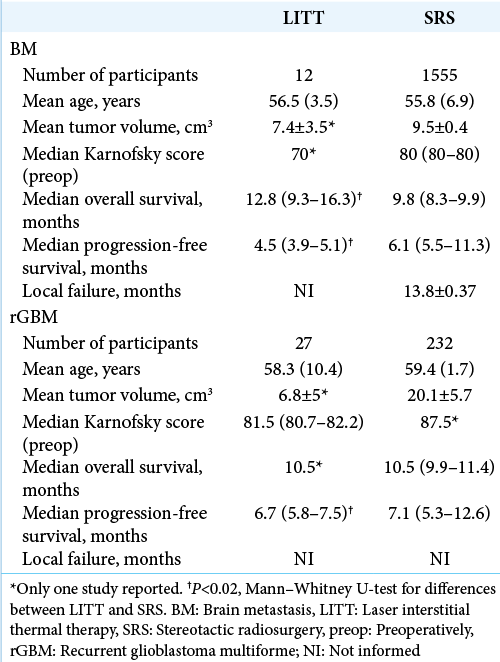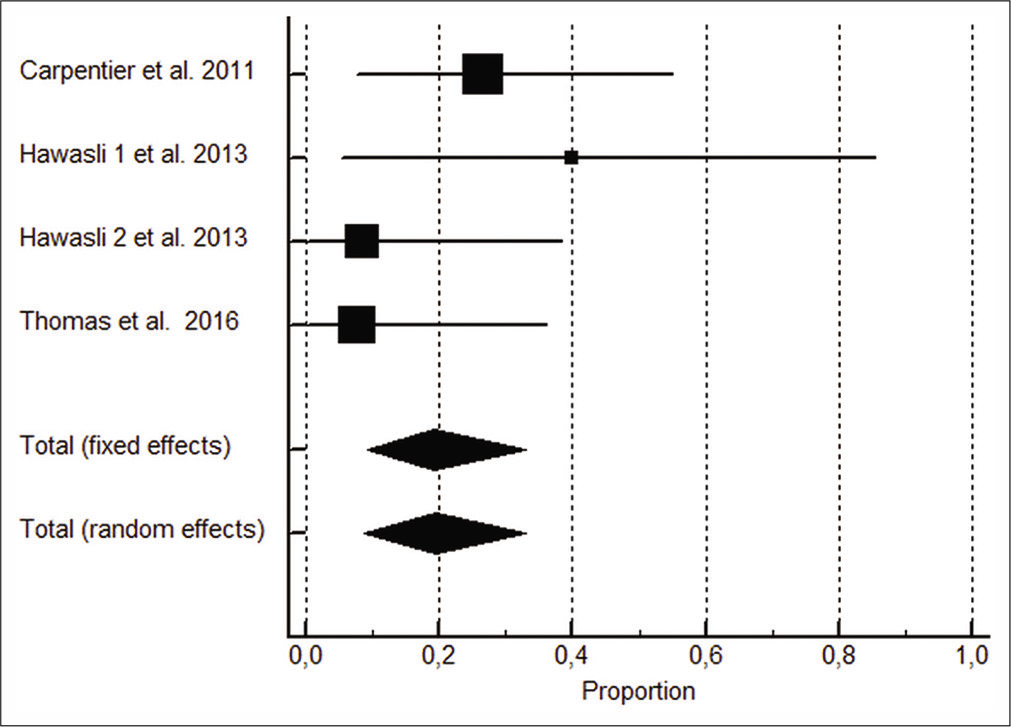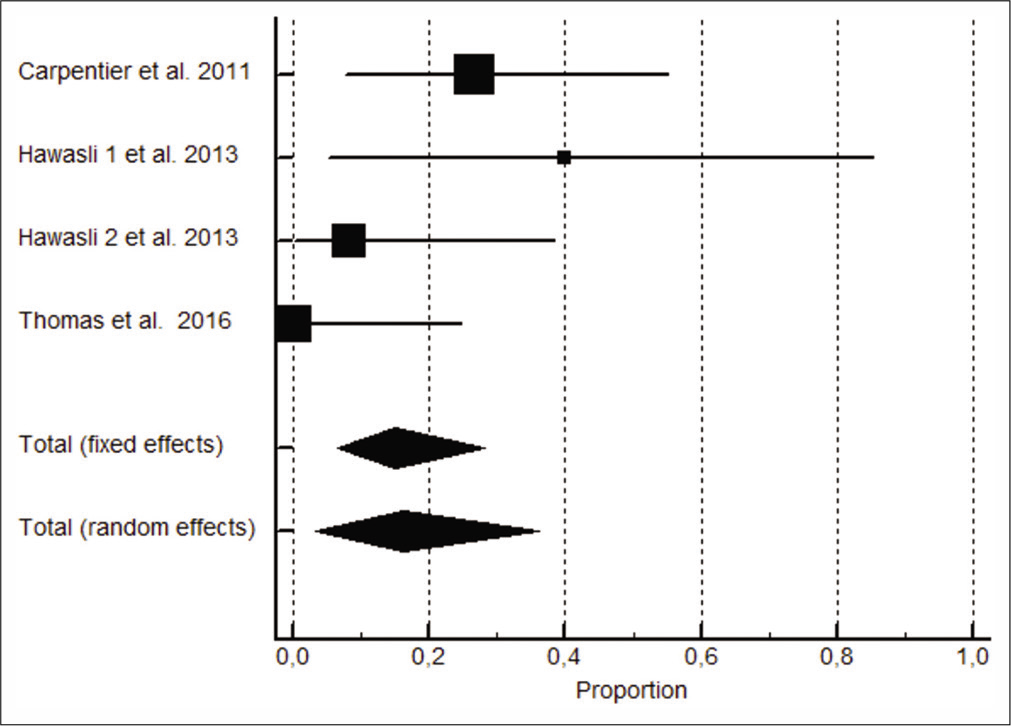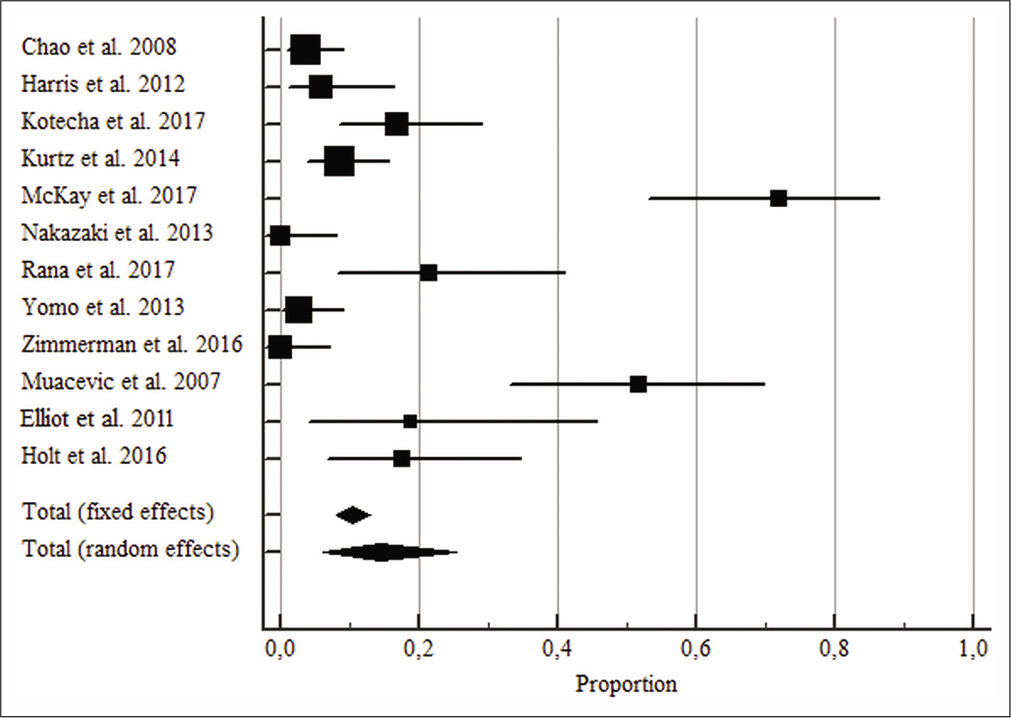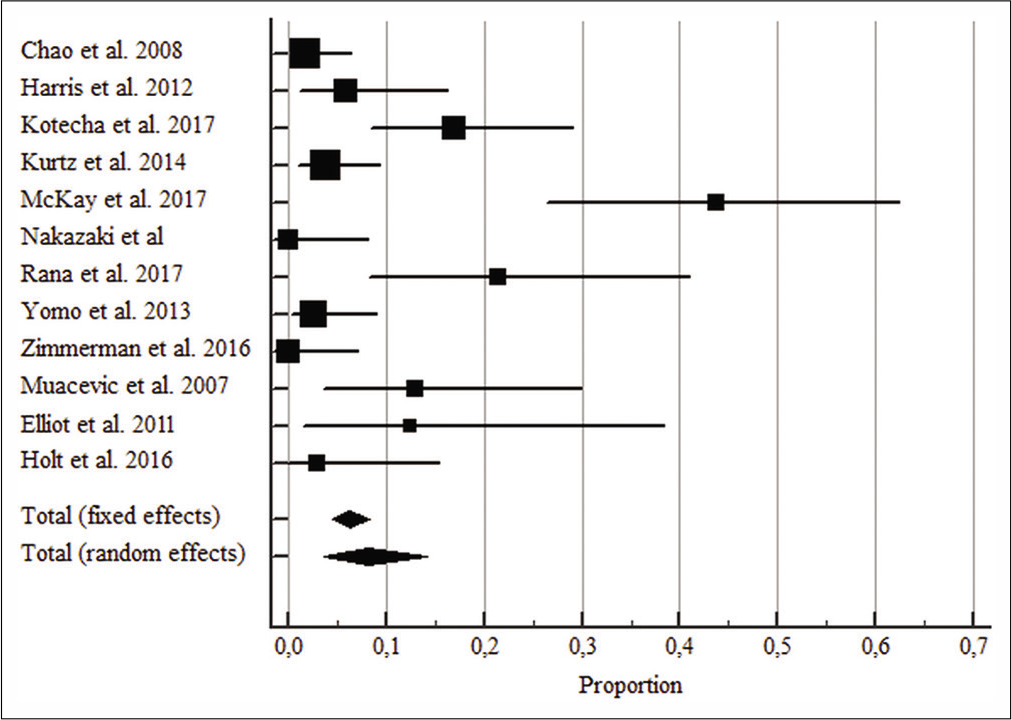Minimally invasive procedures are gaining widespread acceptance between neurosurgeons for treating brain tumors in recent years. For oncology patients, where clinical conditions are seldom optimal, the avoidance of invasive procedures[ 4 ] is preferred. Moreover, some tumors are located in difficult-to-access areas, further precluding surgical options. In those cases, Gamma Knife, linear accelerator, or proton beam-based stereotactic radiosurgery (SRS) are often assessed as the treatment of choice, particularly in the context of limited intracranial disease and preserved general condition; however, other forms of radiation treatment such as fractionated stereotactic radiotherapy and whole brain radiotherapy (WBRT) may also be considered when SRS is deemed not feasible.
Laser interstitial thermal therapy (LITT) has recently emerged as a minimally invasive technique for percutaneous tumor cytoreduction.[ 57 ] LITT therapy is used simultaneously with MRI thermography, allowing real-time thermal imaging and greater control of laser energy delivery, diminishing iatrogenic injury.[ 7 , 52 ] This study aims to compare SRS therapy with LITT in brain metastatic disease and identify a possible role in the management of recurrent glioblastoma (rGMB).
Selection of studies
This study was conducted in conformity with the Preferred Reporting Items for Systematic Reviews and Meta-Analyses (PRISMA) guidelines.[ 59 ] We performed a search in Lilacs, PubMed, and Cochrane database, using the following search terms association: LITT, brain tumors, brain metastasis, and recurrent GBM. SRS studies were searched using the following terms: brain metastasis, recurrent GBM, palliative care, life expectancy, second-line treatment, second-line therapy, rescue treatment, rescue therapy, salvage treatment, and salvage therapy. SRS was defined as a single or few fractions of high-dose radiation to a small intracranial target that was encompassed by at least 50% of the prescribed dose. One filter was applied within the publication period, which refers to accepted papers published after October 1, 2007, due to FDA clearance for Visualase®, in July 2007,[ 58 ] which recognizes laser therapy in brain tumors. The close-out date was January 2019. Studies were included if (1) written in English, Portuguese, French, and Spanish, (2) LITT or SRS was the single therapy employed as treatment in an adult cohort (≤18 years old), and (3) presented in some measure, the median overall survival (MOS), progression-free survival (PFS), and adverse events related to treatment in patients. Retrospective studies, prospective analyses, and case series were included in the review. Excluded studies were those without full reports, commentaries, editorials, and reviews.
Data extraction
A standardized data extraction form was used by two investigators (SAF and ASMS) and checked by the other authors. Any discrepancy was settled by consensus. The following data were extracted from all studies included: study design, year, patient’s demographics, tumor location and volume, therapy used, Karnofsky performance status (KPS) score before treatment, and patient outcome (MOS, PFS, local failure, and adverse events). Data were also extracted regardless of whether LITT and SRS procedure were performed for the treatment of BM or rGBM. Two investigators (SAF and ASMS) independently performed a systematic review of all identified citations.
Risk of bias
The methodological quality of eligible studies was independently assessed by two reviewers (SAF and ASMS) using the Cochrane Collaboration tool.[ 28 ] Disagreements were resolved through discussion with a third reviewer (WMT).
Measures of treatment safety
Adverse event rates were calculated as the number of patients with at least one side effect divided by the total number of patients included.[ 15 ] These data were pooled using meta-analysis of proportions, using MedCalc 16.2.0, were performed to estimate an overall weighted proportion and its 95% confidence interval (CI) of adverse events. MedCalc uses a Freeman-Tukey transformation to calculate summary proportions weighted according to the number of patients described in each study. We determined the pooled proportion using a random effects model. Conversion to a mean and standard deviation in studies where median and range only existed was accomplished using the methodology described by Hozo et al.[ 31 ] The pooled proportion with its 95% CI is displayed as a diamond at the bottom of the figure. For each meta-analysis, the number of studies with reported outcomes is presented in the text.
Heterogeneity between the studies was assessed using the χ2 test on Cochran’s Q statistic and by calculating I2 values of heterogeneity separately for 25% (low), 50% (moderate), and 75% (high).[ 28 ] Conversion to a mean and SD in studies where median and range only existed was accomplished using the methodology by Hozo et al.[ 31 ] The Mann–Whitney U-test was used to compare the variables’ median between LITT and SRS interventions.
The database search identified 142 LITT studies. After screening the titles and abstracts according to the selection criteria, 13 full texts were fully read. Four articles (one[ 12 ] for BM, two[ 77 , 81 ] for rGBM, and one[ 27 ] for BM and rGBM) were selected for this systematic review and meta-analysis. Since Hawasli et al.[ 27 ] measured LITT in BM and rGBM groups, we considered this article as two studies. For SRS review, a total of 1412 potentially relevant articles were identified. After examination of the titles, abstracts, and full texts, 21 studies (17 for BM[ 1 , 10 , 14 , 20 , 24 , 25 , 32 , 39 , 45 , 46 , 61 , 63 , 70 , 85 , 86 ] and 4 for rGBM[ 17 , 30 , 41 , 65 ]) met inclusion criteria [Figures S1 and S2] for the PRISMA flow diagram of LITT and SRS included studies, respectively. In all studies, it was not clear if either patients or clinicians were blinded. Risk of bias assessment is demonstrated in [Figures S3-S6].
General characteristics of the studies are listed in [Table S1]. Only two LITT studies[ 12 , 27 ] described the median total procedure duration (median of 308.6 min, ranging from 135 to 364 min). Median hospital stay was 69 h (range 30–106.8 h) in LITT group. However, this information was not available in SRS studies. The median time since diagnosis and LITT intervention was present in two studies: 457 (Sloan et al.[ 77 ]) and 485 (Thomas et al.[ 81 ]) days. Only one study[ 55 ] presented this data in SRS group (250 days).
The total number of participants was significantly higher in SRS studies (1787 patients; 1555 with BM and 232 with rGBM) when compared to 39 patients in LITT studies (12 with BM and 27 with rGMB). Apart from the discrepancy in the number of participants, studies fairly matched baseline characteristics, KPS score before treatment, MOS, and median PFS [ Table 1 ]. Patient’s preprocedure evaluations and outcomes were not reported in a systematic way, making this analysis difficult. For LITT therapy, Hawasli et al.[ 27 ] were the exclusive source of tumor volume in BM group (mean of 7.45 ± 3.5 cm3) and Sloan et al.[ 77 ] in rGBM group (mean of 6.8 ± 5 cm3). As for SRS therapy group, tumor volume was evaluated in nine BM studies[ 10 , 20 , 32 , 39 , 45 , 46 , 55 , 70 , 85 ] presenting a mean of 9.5 ± 0.4 cm3, and in three rGBM articles,[ 17 , 30 , 41 ] mean of 20.1 ± 5.7 cm3.
Table 1:
Patient’s characteristics and clinical outcome.
Clinical outcome evaluations post-LITT treatment were postoperative KPS scores,[ 27 , 77 ] MOS,[ 12 , 27 , 77 ] median PFS,[ 12 , 27 , 81 ] and neurological deficits assessments[ 12 , 81 ]. Hawasli et al.[ 27 ] described deterioration in postoperative KPS scores after LITT (mean, 74.1 ± 9.4 [before] and 63.8 ± 16.0 [after] LITT). On the contrary, KPS improvement after 14 days of LITT was described (increase of 13.3 points on the average) by Sloan et al.[ 77 ] All SRS studies (one exception applied[ 55 ]) described MOS, whereas, median PFS was reported in 11 studies[ 1 , 10 , 17 , 20 , 39 , 45 , 55 , 61 , 70 , 85 , 86 ] [ Table 1 ]. No KPS scores or other neurological evaluations after SRS treatment were described.
Only five SRS studies performed local failure analysis in BM patients,[ 32 , 45 , 55 , 70 , 86 ] with a mean of 13.8 ± 0.37 months for a total of 240 patients. No other study in LITT therapy for BM presented the same analysis. These data were absent in rGBM group. Correlations between aspects (e.g., MOS, KPS, and local failure) with primary cell of BM were not reported.
Adverse events were standardized and stratified by the level of severity following author’s description. One LITT study[ 77 ] did not provide data per subject and was excluded from the meta-analysis, meanwhile, 12 SRS studies[ 14 , 25 , 30 , 33 , 45 , 46 , 55 , 61 , 63 , 70 , 85 , 86 ] reported adverse events. [ Table SII ] for all adverse events stratified by therapy used, type of brain tumor (BM or rGBM), and symptom.
The pooled prevalence of adverse events in brain tumor patients after LITT was 19.3% (8/45 individuals, 95% CI 8.6–33.0%), in the overall sample [ Figure 1 ]. No evidence of between-study heterogeneity was observed in the meta-analysis (I2 = 18.4%, P = 0.29, Q = 3.6). Only one study[ 81 ] described a nonserious adverse event (one event out of 13 subjects), therefore, no further analysis was performed. Contrary, significant evidence of between-study heterogeneity was observed in the random effects meta-analysis of the proportion of serious adverse events (I2 = 61.8%, P = 0.04, Q = 7.8), showing the prevalence of serious adverse events in brain tumor patients after LITT of 16.1% (95% CI 3.2%–87.21% [ Figure 2 ]).
Figure 1:
Forrest plot for meta-analysis proportion of adverse events after laser interstitial thermal therapy.
Figure 2:
Forrest plot for meta-analysis proportion of serious adverse events after laser interstitial thermal therapy.
The proportion of adverse events in SRS studies was 10.2% [95% CI: 8.0–12.8%, Figure 3 ]. Furthermore, there was strong evidence of between-study heterogeneity (I2 = 92% CI: 88–94.7%, P < 0.0001, Q = 138.4 df = 11). Similarly, the proportions of severe and nonsevere adverse events were high across studies after SRS (3.9%, 95% CI: 2.5–5.8%, Figure 4 ; and 6.1%, 95% CI: 4.4–8.3%, Figure 5 for serious and nonserious adverse events, respectively). The studies exhibited significant heterogeneity for both severe (I2 = 86.1% CI: 77.0–91.6%, P < 0.0001, Q = 72.2 df = 10) and nonsevere events (I2 = 83.7% CI: 72.9–90.1%, P < 0.0001, Q = 67.5 df = 11).
Figure 3:
Forrest plot for meta-analysis proportion of adverse events after stereotactic radiosurgery.
Figure 4:
Forrest plot for meta-analysis proportion of severe adverse events after stereotactic radiosurgery.
Figure 5:
Forrest plot for meta-analysis proportion of nonsevere adverse events after stereotactic radiosurgery.
In the combined comparison of LITT versus SRS, 15% reduction in the absolute risk difference (−0.16 [95% CI −0.27, −0.5]; P < 0.0001; Mantel-Haenszel RE model) was identified, favoring LITT.
Difficult-to-access tumors are frequently treated with radiation therapy modalities, chemotherapy, and/or molecular target therapy.[ 67 ] However, these therapies do not present the same efficiency as tumor mass reduction by surgical resection does.[ 2 , 6 ] Nevertheless, surgical resection followed by hypofractioned radiotherapy or single fraction SRS to the cavity, can present some shortcomings, among them: (i) increase the risk for developing leptomeningeal disease, particularly in cases with posterior fossa location and/or dural engagement;[ 35 , 48 , 51 ] (ii) insufficient margins covering the tumoral bed due to perilesional organs at risk and dose-volume histogram restrictions;[ 78 , 79 ] (iii) possible limitations associated with cavity volume dynamics following surgical procedure;[ 3 ] (iv) increased risk for adverse radiation effects (ARE) when higher prescription doses are required when confronted to “radioresistant” histology (i.e., high-grade gliomas and metastatic lesions such as melanoma and renal cell histology);[ 18 ] and (v) the radiobiology behind adjunctive single fraction SRS may ultimately preclude the postsurgical outcome unless a substantial amount of tumor remains unresected.[ 8 , 37 , 74 ] However, when selectively applied, SRS can provide longstanding tumor control with limited toxicity even in the presence of precluding factors such as radioresistance, regional eloquence (including brainstem location), and/or perilesional edema;[ 16 , 75 ] the latter is best observed in patients with acceptable RPA (1–2)/KPS (70 or more) at pretreatment as well as with nonleptomeningeal metastatic brain disease.[ 75 ] In recent years, LITT has emerged as complementary treatment option for brain tumors using minimally invasive cytoreductive modality.[ 71 , 72 ] There is no consensus protocol for LITT yet, however, it has been commonly applied in four situations: (a) recurrence postresection and maximal adjuvant therapy; (b) high risk for postsurgical complications due to concurrent comorbidities and/or location; (c) safeguarded brain trajectory for LITT; (e) tumor volumetric thresholds of up to 30 mm in diameter; and (f) patient’s preference.[ 34 , 36 ]
Brain tumor’s patients have a shorter life expectancy,[ 19 , 49 , 62 ] and differences can be observed according to treatment modality, apart from side effect analysis. BM patients in palliative WBRT can achieve 2–3 months of life[ 42 , 44 , 64 ] and with EGRF-TKI-based target therapy (gefitinib or erlotinib), life expectancy can reach 7.5 months.[ 80 ] In SRS modality, rGBM patients can achieve 5–7 months of life, when submitted to hypofractioned SRS or temozolomide. [ 26 , 40 , 53 ] For BM patients, 10–12 months of life are achievable, after surgical resection[ 9 ] or when using exclusive SRS therapy.[ 84 ] However, in SRS, the MOS decreases with the increase of the number of metastasis and patients often succumb due to uncontrolled primary disease or out of the field progression.[ 29 , 60 ]
In our study, LITT for BM patients presented a higher MOS when compared to SRS (12.8 vs. 9.8 months). However, only one LITT study demonstrated MOS evaluation, which weakens the comparison among treatments. In rGBM patients, MOS analysis was also deficient by its absence in 66% of our studies, demonstrating the need for additional clinical research and data collection consistency. Moreover, differently from SRS, LITT presents some shortcomings due to lesions characteristics that are unfavorable for its application,[ 34 , 68 , 73 ] which are diffused bilateral or multiple lobes lesions, large lesions that would result in subtotal treatment (lesion diameter >3 cm), hypervascular lesions, and poor preoperative functional status (KPS <70 – RPA III[ 22 ]). In addition, deaths by neurological deterioration were already associated with poorer functional status when compared to systemic deaths between LITT patients.[ 38 ] Our study could not analyze this association due to missing data on our pooled studies.
The PFS analysis can assist in treatment choice due to its significance.[ 49 ] For rGBM patients, exclusive radiotherapy and surgery interventions (with chemotherapy agents) present a median PFS of 7.7 and 9.0 months,[ 50 ] respectively. Our results evidenced that LITT therapy had a lower PFS compared to SRS for brain metastasis and rGBM patients. However, in both pathological groups and therapies, these analyses were impaired due to data irregularity (3 of 5 studies in LITT therapy and 11 of 21 studies in SRS therapy). Likewise, KPS analysis was impaired due to the singular availability of data in LITT for BM and in SRS for rGBM.
Brain tumor patients usually experience disease and treatment burden by an aggregation of symptoms that reduce the quality of life, such as imbalance, nausea, fatigue, cognitive dysfunction, and altered mood states.[ 5 , 11 , 69 , 82 ] Sleep disturbance can reach up to 52% among brain tumor patients.[ 23 , 83 ] Fatigue can occur in 89% of patients with recurrent malignant gliomas, and headache is the most common type of pain.[ 66 ] When surgery and SRS are not indicated, the application of LITT therapy could aim the control of symptom’s aggregation, also known as symptom cluster,[ 47 , 56 ] can directly affect up to 62% of the quality of life in high-grade glioma patients.[ 21 ] Although LITT presented 15% lower absolute risk for adverse events when compared to SRS treatment, the current scientific evidence could not support LITT superiority. Based on the aforementioned observation and in the absence of contraindications, we suggest that LITT should be considered as an optional adjunct therapy when resection and SRS are deemed not feasible or optimal, yet a prompt neurosurgical intervention is required to obtain local tumor control and salvage of the neurofunction in safe manner. As in the case of SRS, the latter strategy aims to avoid further neurodeterioration, likely to preclude the use of systemic treatment to fight extracranial disease.[ 76 ]
Limitations existed in this meta-analysis. Studies singularities were noted among the adverse events, such as repeated setting of SRS on the same target[ 55 , 70 ] along with the increased radiation exposure, which could influence the higher rate of adverse events observed. This was confirmed by high heterogeneity between SRS studies and moderate heterogeneity in serious adverse events for LITT patients. Higher heterogeneity in SRS studies could be explained by the methodological diversity such as inclusion criteria (e.g., gathering radioresistant and radiosensitive tumors[ 61 ]), procedures routines, and extended range of years when research was accomplished. Likewise, single fraction SRS can be applied in patients with up to 10 lesions[ 29 ] which is not the case in LITT. With lesions >3 cm, hypofractionated SRS can be safely applied, decreasing the risk of ARE.[ 75 ] The resultson LITT resulted in a lower risk of bias evaluation since a lower sample of studies was noted during a smaller time frame for studies accomplishment, which are characteristic of a therapeutic novelty.
Heterogeneity can be further interpreted due to clinical diversity, present in both treatment groups, such as a variety of previous treatments (due to patient’s recurrence stage), systematic staging evaluation, higher treated volume in rGBM in SRS arm than in LITT arm, and pooling of metastatic diseases without deeper correlation of prognostics. None of LITT studies for BM clearly classified disease progression, thus, not enabling to estimate a matching comparison with SRS studies. In rGBM patients, two studies in LITT group and three studies in SRS group presented disease staging assessment, however, it did not allow to compare treatments techniques.
Brain metastasis patients, in both treatment options, were analyzed as a unique population when outcomes were presented because the authors did not make a distinction of primary diagnosis, which turned impossible for in-deep analyzes. As previously mentioned above, some SRS studies demonstrate that active extracranial disease can have a negative influence on short term survival[ 43 , 54 ] therefore affecting MOS outcome. However, there was insufficient information on the primary cause of death, either direct related with the brain tumor or from systemic causes.
In the LITT group, clinical diversity resulted from the deficiency in outcome measures: one article did not present PFS and KPS evaluation after treatment, another article did not present MOS, and the third one presented an estimated MOS. In the SRS group, clinical diversity was influenced by the absence of patient’s age (2 articles), KPS posttreatment evaluation (9 articles), and PFS (9 articles). Overall, higher risk of bias affected the estimation of the intervention effect and emphasized the deficiency of structured randomized trials. Thus, a successful treatment should be interpreted by presenting acceptable survival rates and its influence on patient’s quality of life, during and after treatment. A considerable majority of our results did not demonstrate patient’s functional analysis after treatment, rending unfeasible further inquiry into the patient’s daily life and independence after treatment, and demonstrating the need for randomized trials.
Furthermore, treatment centers are also readapting to new health-care demands. The global crisis caused by coronavirus disease 2019 obligated a revision on health-care protocols to reconsider patients’ logistics and resources optimization.[ 13 ] When considering this context, SRS presents obvious advantages in the oncological high-risk population since it does not demand a full staffed operation room, airway manipulation, it is a less invasive procedure, and finally, the patient is discharged on the same day.
At present, there is no evidence that LITT can be used as a treatment of choice when compared to SRS. However, our results suggested a positive role in lowering the absolute risk of adverse events when compared with SRS therapy. Although the latter results warrant careful interpretation, we suggest that LITT can be applied in selected cases, that is, when surgical removal and SRS (single dose or hypofractionated) are deemed not feasible or in the case of local progression postoperative/post-SRS. Randomized trials are encouraged to ascertain the upfront or adjunct role of LITT in comparison to currently used modalities.


